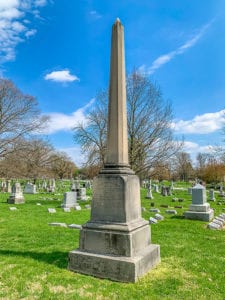Healthcare Heroes of the Past
During the COVID-19 pandemic, as we are so grateful for the doctors, nurses, and others in the medical profession on the front lines of this battle, we want to highlight two individuals at Crown Hill remembered for taking care of those who were sick or wounded.
 John Emil Renner. M.D. (1850-1878)
John Emil Renner. M.D. (1850-1878)
John Emil Renner came to the United States from Germany as a teenager in the late 1860s. After graduating from the University of Louisville, he came to Indianapolis to practice medicine. When news came that Father Damien had died in the service of lepers in the Hawaiian Islands, Dr. Renner left town to serve on the Hawaiian Island of Molokai, returning to Indianapolis after a few years.
Soon after his arrival back in the states, the city of Memphis was hit hard by malaria. Again, against the advice of his friends, he left to go where he felt most needed, arriving in Memphis on August 29, 1878. He tended to the suffering until September 11, when he himself was stricken, and died on September 16.
Struck by the courage of this “victim in the cause of humanity,” his fellow members of the Second Presbyterian Church erected a cenotaph to his memory clearly visible on the northwest corner of Section 16, as you drive towards the Crown.
 Catharine Merrill (1824-1900)
Catharine Merrill (1824-1900)
Nursing as a trained profession was in its infancy in the United States when the Civil War broke out. To meet the great need to aid the sick, wounded, and dying, many American women volunteered to serve in hospitals both near the battle front and the home front. One of these women was Catharine Merrill, a well-known Indianapolis teacher. Catharine sometimes led her students, the daughters of some of the city’s leading citizens, on nursing trips both to Camp Morton, a Civil War prisoner of war camp on the near north side of Indianapolis, and to nurse Indiana soldiers near the battlefield. One such soldier remembered Catharine with these words: “There was a lovely lady who left her home of comfort and refinement and came to the army in the field. I saw her, basin and towel in hand, going from cot to cot, washing the feet of the sick, the wounded, and the dying. The act was done with such gracious humility, as if it were a privilege, that I turned my head away with my eyes filled with tears.”
Catharine may be best remembered for some nursing she did after the war. In 1869, young John Muir, who later to become the great naturalist and “Father of the National Parks,” was living in Indianapolis. Of that time, he later wrote: “It was in a time of trouble that I learned to know Catharine well. While at work in a mill my right eye was pierced by a file, and then came the darkest time of my life. I was blind for months, and the blindness threatened to be lasting and complete. She came to my room an angel of light, with hope and cheer and sympathy purely divine, procured the services of the best oculist, and the children she knew I loved. And when after long months of kindness and skill she saw me in heaven’s sunshine again, fairly adrift in the glorious bloom of the spring, her joy was as great as my own.”
That same year Catharine took a position as professor of English at Northwestern Christian University (now Butler), becoming the second female university professor in the United States. She is buried in Section 7, Lot 16 beside her father, Samuel Merrill, the Indiana State Treasurer who had moved the state’s treasury from Corydon to Indianapolis on a handful of oxen-drawn wagons when Catharine was just a baby.

